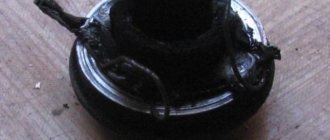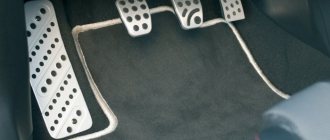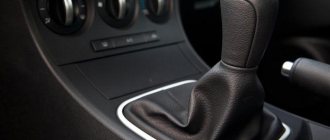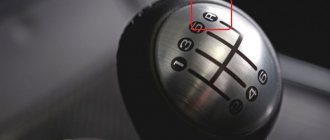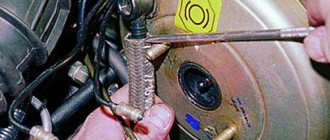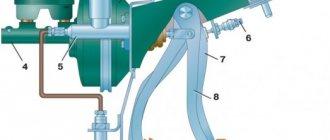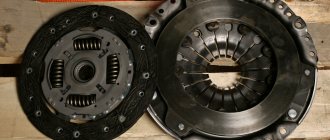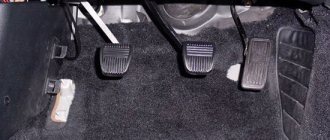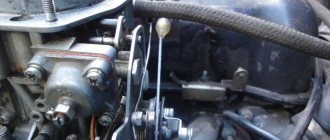Like any complex mechanism, the clutch fails from time to time. Listed below are the types of breakdowns, their symptoms, the reasons why this occurs, and tips for troubleshooting.
Experienced drivers are well aware of the design and principle of operation of the clutch. But among beginners, not everyone can boast of such knowledge. Therefore, before talking about malfunctions, it makes sense to understand what they are.
Model...
The physical principle on which the operation of the coupling is based is the presence of frictional force between the contacting surfaces. A simplified model of this device can be represented as two coaxial disks, a master and a slave. One of them can move under the action of a control lever. The first is connected to the drive. The second one is connected to the transmission.
When starting to move, the driver “squeezes the clutch” and the discs separate. The slave is motionless, i.e. the clutch is in the "disengaged" position. Then the driver engages first gear, adds gas and gradually releases the pedal. The disks are getting closer. At some point, their surfaces begin to contact each other, but still with slipping.
Therefore, the slave also begins to rotate, but its torque is less than that of the master. Next, the first disk is pressed more tightly against the second, slippage decreases, and the driven one rotates faster and faster. After the disks are completely pressed against each other, the slippage is zero and the angular velocities are the same. The clutch is engaged.
...And in reality
Compared to the physical model described above, the car clutch will be more complex. Although the principle of operation is the same. The main nodes are:
- Basket. Screwed to the flywheel. In its center there are pressing petals, and on the inside there is a movable pressure disk.
- Driven disk on the gearbox shaft. In its center there are damper springs in a circle. On one side there is a flywheel, on the other there is a basket.
- Movable release bearing. Makes the petals bend.
For better contact, both discs have wide annular surfaces with increased roughness. The same goes for the flywheel.
If the clutch is engaged and the motor is connected to the transmission, the pressure plate presses the driven one against the flywheel. When the driver presses the clutch pedal to turn it off, the bearing bends the petals. The discs move apart. The connection between the motor and the transmission is interrupted.
When the pedal is completely released, the pedal returns to its original position. The friction planes again touch one another and remain in this state, imparting torque from the engine to the gearbox. That. The car's clutch is a normally engaged mechanism.
Clutch operating principle
The clutch is responsible for transmitting torque from the engine to the gearbox. Its main task is to disconnect the units at the moment of switching speed. It is worth noting that this mechanism is different on cars with automatic and manual transmissions. On engines with a robotic transmission, the interaction with the engine is slightly different, and its functions are controlled electronically.
If we omit all the nuances, the clutch consists of the following components:
- The drive connects the pedal and the clutch itself (there are several options: mechanical, with a cable and hydraulic). On a robotic transmission, the drive is activated by an actuator, which receives commands from the ECU.
- Basket. Consists of a release bearing and a pressure plate.
- Driven disk.
- Fork.
- Damper springs.
- Control pedals.
When you press the pedal, force is transmitted to the clutch fork via a cable or hydraulic cylinder. The fork, through the release bearing, mechanically acts on the petals of the pressure plate, which, under the influence of this force, bends towards the flywheel. This causes the driven and driven discs to lose traction and the engine to idle without any load on the wheels.
Clutch functions on the bob
The clutch serves to transmit torque from the motor to the checkpoint (Checkpoint - a point designed to control passage (visit) and access to the territory of any facility)
, after which the moment is transmitted to the wheels. In simple words, the clutch disc is pressed against the flywheel on the crankshaft.
It is possible to press and release the disc from the flywheel using the clutch pedal, which the driver uses to practically influence the clutch drive. When the pedal is in the up position (the pedal is not pressed), the disc is pressed. If the pedal is depressed, the disc and flywheel are disconnected. It turns out that by pressing the pedal the driver disengages the clutch.
In the hydraulic version, the cable is replaced by cylinders (as in the brake system) and the principle of incompressible water (in this case, brake) is used. Most often, modern cars have a hydraulic drive installed, because it is the most advanced and reliable. In any case, when the car has a very soft clutch pedal, the gears do not engage and other difficulties appear with shifting, normal operation without repair is simply impossible.
How the clutch works, what are its typical malfunctions, and how to avoid them
An important element of a manual transmission is the clutch, which serves to briefly disconnect the engine from the transmission. In addition, the clutch is a kind of damper that protects the engine from overloads. How does it work and how to extend its life?
How does the clutch work?
Most passenger cars with a manual transmission use a dry single-plate clutch. Its design is quite simple: it consists of two mutually adjacent disks - a drive (basket) and a driven one, a release bearing and a drive system. In the single-disc version, the transmission input shaft fits into a splined clutch in the center of the driven disk, and the surfaces of the engine flywheel, driven disk linings and basket pressure disk fit tightly together. Due to this, the transfer of power flow from the engine to the gearbox is ensured, and a working clutch calmly “digests” all the power developed by the engine.
In everyday life, the clutch drive disc, which includes a pressure plate (with a smooth shiny surface), a diaphragm spring (petals in the center) and a casing, is called a basket
When you press the clutch pedal, the release bearing acts on the plate springs of the basket, causing the surfaces of the driven and driving discs to separate. Accordingly, the input shaft is disconnected from the flywheel - that is, the engine and gearbox are physically disconnected, which allows you to change gear or engage neutral. When the clutch is engaged (the pedal is released), the release bearing stops pressing on the leaf springs, and the discs close again, and the damper springs in the central part of the driven disc dampen the torsional vibrations that occur during movement.
The four damper springs of the clutch driven disc are clearly visible, as well as the worn friction linings
When the clutch operates normally, it does not attract attention to itself. But if it malfunctions, the driver, for example, will not be able to shift gears or move away. What problems are possible?
Short clutch lever and easy do-it-yourself squeezing
There are two ways to make the clutch release on a motorcycle softer.
This modification is more relevant for enduro sports motorcycles, since the clutch has to work a lot.
You can buy a ready-made lever on Aliexpress for 1400-2000 rubles, but you can save money and make a similar lever almost for free.
The ease of pressing the clutch depends on the distance between the center of the axis of fastening the clutch lever to the bracket and the center of fastening the cable to the lever.
The shorter the distance, the easier the squeeze, but the cable travel is less. If the distance is too small, the cable will not have enough travel and the clutch will not disengage completely.
If your motorcycle allows you to press the clutch with one or two fingers, then in your case it is possible to make it easier to press.
The main reasons for a soft clutch pedal
To depress the clutch pedal when the drive is fully operational, you need to apply a certain force. This setting can be adjusted. Some drivers deliberately use a soft clutch. However, most often this is a sign of breakdowns and malfunctions, especially if the driver notices a difference compared to the norm. For mechanical and hydraulic drives, the problems will be different, not counting cases of mechanical failure of some parts.
- Let's start with the hydraulic clutch drive. First of all, air in the system is a common problem. During any repair of the hydraulic drive, air enters the tubes. This makes the pedal stroke soft. In this case, you should check the quality of tightening of the pipeline fittings, and also bleed the entire system (bleed the hydraulic drive).
You can also highlight a malfunction of the clutch slave and master cylinders. The working cylinder most often jams, and when the main cylinder fails, it loses its tightness and, as a result, its pumping capacity.
If the clutch pedal becomes soft in the cold season after the car has been idle, and during warming up everything returns to normal, then you need to check the master cylinder. Most likely his cuff will have to be replaced.
- The mechanical clutch drive is also characterized by a number of breakdowns. It is more difficult to identify a problem in a mechanical clutch drive, since you will often have to disassemble the crankcase and get to the release bearing.
Its deformation, as well as the breakage of the drive foot, are most often the cause of a soft clutch. The problem may also be associated with the destruction of one or more damper springs of the driven disk. Often this can also be found out only after disassembly.
What's the result?
If the clutch becomes soft without special adjustments, you need to look for the reasons and carry out repairs as soon as possible. Remember, driving with a faulty clutch is unsafe and also leads to increased wear of various parts, elements and assemblies.
Finally, we note that a complete replacement of the entire drive is required only in certain cases. As a rule, it is possible to limit oneself to replacing some individual parts and subsequent adjustment/adjustment of the clutch drive.
How to change gears without a clutch: driving a manual car without a clutch in case of malfunction. Tips and tricks.
Gears are difficult to engage or speeds on a manual transmission do not engage: the main causes of the malfunction and possible problems.
Correct gear shifting in a car with a manual transmission: when to engage a particular gear on a manual transmission, working with the clutch pedal, errors.
Car clutch: purpose, types, design, principle of operation. Frequent clutch malfunctions in the vehicle transmission system, signs of problems.
Reasons for difficulty shifting gears with the engine running. Transmission oil and level in the gearbox, wear of synchronizers and gearbox gears, clutch.
How is the clutch implemented in the transmission device on cars with automatic transmission compared to a manual or robotic transmission. Features and differences.
Most often, modern cars have two types of clutches:
- with a mechanical drive
- the clutch fork is connected to the pedal in the cabin using a cable; - with a hydraulic type drive
- the gas pedal is connected to the clutch slave cylinder by a pipeline filled with working fluid.
The adjustment procedure depends on the type of unit.
Adjusting the mechanical clutch
First, let’s find out whether the pedal stroke decreases or increases. We press the pedal all the way and measure how far from the floor it stops. Let's release the pedal and take measurements again. From the second indicator we subtract the first. For most models, the normal stroke amplitude is in the range of 12 - 14 cm, this can be clarified in technical documents. If the number is less, the pedal stroke needs to be increased, if it is more, it should be decreased.
After the measurements, we move on to the adjustment procedure itself:
Stage 1
– open the hood, find a rod near the transmission lever that secures the cable coming from the clutch pedal.
Stage 2
– lubricate and loosen the nuts that secure the rod with liquid lubricant.
Stage 3
– using wrenches, turn the nut that was closer to the pedal. If you turn the nut towards the clutch pedal, the free play of the pedal will become greater, if in the opposite direction - less.
Stage 4
– again measure the amplitude of the pedal stroke. If it is within the normal range, tighten the second nut – the control one – until it stops. This is necessary to record the adjustments made. If the stroke is still too large or small, tighten the nut that is closer to the pedal.
Checking the clutch operation. The pedal should be pressed easily, without noise or friction. When starting, the car should not slip or move jerkily. Speeds should change smoothly and accurately.
Adjusting the hydraulic clutch
Hydraulically operated clutches are mostly self-adjusting. But you can also adjust them manually if the pusher on the working cylinder has a thread and a control nut. Here's how to do it:
Stage 1
– check the level of working fluid in the clutch. It should be at a normal level.
Stage 2
– we create conditions for working under the machine. You can place the car on a ramp or risers, use a lift or inspection pit.
Stage 3
– we look for the pusher of the working cylinder.
Stage 4
– unhook the spring from the fork with pliers. Push the fork forward as far as possible and measure the distance between it and the pusher rod. We release the fork and take the same measurements. We get the size of the clutch gap, which we check with the standard one. If it does not fit into the range specified in the technical documentation (usually about 5 mm), we make an adjustment.
Stage 5
– remove the spring installed on the bracket of the working cylinder and fork.
Stage 6
– loosen the fixing nut on the threaded connection of the pusher, turn the adjusting nut in the direction of the working cylinder to increase the size of the gap. Or in the opposite direction - to reduce them.
Stage 7
– tighten the control nut when the gap dimensions become normal.
At the end, we carry out a control check of the clutch operation.
The hydraulic clutch, like the mechanical clutch, can be adjusted manually
As you can see, problems associated with the clutch on a manual transmission in some cases can completely immobilize the car. If the problem is related to the clutch pedal, that is, the driver loses the ability to control the operation of the clutch, then repair is also necessary, however, if you have certain skills and abilities, you can drive to a service station or other place where the car is repaired under your own power.
We also recommend reading the article about
how to adjust the clutch pedal
. In this article you will learn when to adjust the clutch pedal, as well as how to adjust the clutch if necessary.
Finally, we note that at each scheduled maintenance it is optimal to check the quality of operation of all important components of the car. The clutch is also no exception. It is necessary to monitor the condition of the clutch cable and change the brake fluid in a timely manner to extend the life of the clutch master cylinder.
If necessary, it is also recommended to adjust the clutch pedal, bleed the clutch, and also take into account even the slightest malfunction of this unit during vehicle operation.
The clutch pedal has become soft: reasons
Types of clutch drive. If the clutch pedal falls, the clutch has become soft, problems have arisen with the clutch: causes and repair of major faults.
Clutch pedal adjustment: how to do it...
How to adjust the clutch pedal, what adjustment is needed for: clutch functions, clutch pedal adjustment (free play and total travel).
After replacing the clutch, the gears do not engage...
Manual transmission gears (speeds) do not engage after replacing the clutch: main reasons, settings and adjustments. Diagnosis of problems, useful tips.
The clutch is slipping
The obvious symptoms of such a clutch malfunction are the following: when you press the gas almost all the way down with the pedal released, the engine “growls”, but the output does not meet your expectations. In addition, you may notice a burning smell coming from the engine compartment.
Reasons for this problem:
- the pedal free play adjustment is broken;
- the friction lining of the driven disk is “contaminated” with oil. Most often, this scenario is typical for cars with high mileage, in which the oil seal or gasket may leak, or leaks in the connections may occur, causing the lubricant to splash under the bottom, ending up on the friction linings. It is in such cases that the smell of burnt oil may be present;
- friction lining wear;
- The problem may be a faulty drive. If you look under the bottom of the car, asking an assistant to depress the clutch pedal, the working cylinder rod should move, pushing the fork. If this does not happen, the breakdown should be looked for in the drive;
- In cars with a hydraulic drive, a similar malfunction occurs due to clogging of the compensation hole in the main cylinder.
When you press the clutch pedal you hear strange noises
If you release the pedal, the acoustic situation returns to normal. The nature of the sounds can be different and manifest itself from a characteristic rustling to an intermittent grinding sound with varying intensity.
- the release bearing fell due to play or lack of lubrication;
- the petals of the basket or damper springs have become unusable;
- The driven shaft bearing on the box is worn out.
The clutch pedal squeaks when pressed and does not return
Try to pull it back with the toe of your boot. If this does not help, that is, the problem does not disappear - the drive is probably jammed. Or the release bearing fell off. Sometimes this is caused by jamming of the pedal spring (most often due to prolonged inactivity) or the master cylinder rod.
The axle bushing in the place where the pedal is attached may creak - just lubricate it.
When you press the pedal hard, the clutch disengages
And if, when you smoothly press/release the pedal, the clutch does not engage (this symptom is typical for a hydraulic drive), then we can talk about the following reasons:
- the tightness of the clutch system line is broken;
- the fluid level in the system is less than permissible;
- The master cylinder cuffs are worn.
First way
The task comes down to finding a suitable lever together with a bracket, where the distance between the center of the cable attachment to the lever and the center of the axis of the clutch lever attachment to the bracket is less than yours.
On the 1995 Kawasaki KLX 250R the specified distance is approximately 30mm. On the Kawasaki Super Sherpa 1997 motorcycle the distance is the same.
On motorcycles Kawasaki KX 60/65/100/125/250F 1994-2008 and KX 250 1994-2004, Suzuki RMZ 450 2005-2008 the distance is about 25 mm.
On my Kawasaki KLX 250R motorcycle I installed a bracket from a Kawasaki KX 250 and a Sunline V1 MDX lever. The clutch became softer, but full release became possible only if you pressed with all your fingers, that is, the lever had to touch the steering wheel.
Let me remind you that for the short, light-squeeze clutch lever that I bought on Aliexpress, the indicated distances are approximately 15 and 22 mm.
The 15 mm distance is not enough for my motorcycle - the clutch does not disengage completely even when the lever rests on the handlebars.
22mm is fine for my bike, but I would try 20mm.
You can go to a store that sells spare parts for motorcycles and look for an option that suits you. You can ask your friends.
There are so many options. But in any case, you will have to look for a lever that is suitable for your case.
We figured it out with a slight squeeze, but to remake the lever for one or two fingers, you just need to shorten it. True, it’s difficult to say whether it will be convenient to use it after such an operation.
How to fix the problem
Knowing that the system is faulty, you need to take measures to repair it. First you need to determine the breakdown, because it is likely that only one part has broken.
Without wanting to spend money, you can solve minor problems yourself:
- lubricating or replacing the release clutch bearing;
- replacing fluid in the hydraulic drive with subsequent pumping;
- changing the driven disc pads or springs if the elements are worn out, weakened or deformed;
- replacing the basket and all parts with a new assembly recommended by the vehicle manufacturer.
Even if these steps are taken, the tightness may still remain. Then you need to try to replace the cable, clean its jacket from dirt and corrosion, and also lubricate it with machine oil. Hydraulic systems can also have cylinder failures, which is also quite serious.
Broken clutch cable
In any case, the most accurate diagnostics can be carried out in services where the nodes are disassembled and their suitability for use is determined. There, the car will be put in order and the stiffness of the lever, which interferes with comfortable driving, will be corrected.
How does a clutch problem manifest itself?
There can be several malfunctions in the clutch coupling, with different external manifestations:
- the clutch does not completely disengage, it “drives”, that is, it partially transmits torque through itself even when fully depressed;
- the opposite situation - the clutch is engaged, but the transmitted torque is very limited or absent, in such cases they speak of clutch slipping;
- at the moment the disks close, abrupt fluctuations in torque, jerks and vibrations occur, the clutch “crushes” and resonates;
- Extraneous noises and odors are heard from the clutch, usually a hum, crackling sound and a burning smell.
Most often, with natural wear and tear, problems begin with the appearance of slipping. Other malfunctions are a consequence or occur due to defective parts and violation of operating rules.
Moderators: mek, indy
Problem with clutch master cylinder and bleeding
#1 Post by dr.emmett » Feb 28, 2014 7:09 pm
The gears stopped turning on normally. The front ones could be plugged in with tension, but the rear ones didn’t turn on at all. The reason is that the clutch was not depressed enough. We decided to pump it up. At first they downloaded according to the rules, i.e. Add fluid to the reservoir and open/close the bleeder valve by pressing/releasing the pedal. At the first opening of the fitting, the clutch pedal became soft and the clutch was completely lost. Several hours of pumping ended in nothing. The liquid kept coming out with bubbles and somehow in very small portions. Accordingly, it also left the tank slowly. All tubes were blown out. We checked that there were no leaks anywhere. When we finally got tired of this activity, we decided to go a different route. We connected the bleeder fitting to the fitting on the brake caliper and pumped it “in the opposite direction” under pressure from the brake system. This made things more fun. The pedal became hard and the clutch started working. I drove around a bit to check - everything was fine. After that I didn’t drive for several days. And when it was needed, it turned out that the clutch again did not work (it would not be squeezed out). They concluded that the main cylinder had died. Because I couldn’t find a repair kit, so I bought a used cylinder assembly. Replaced. We started pumping. Again the same crap - it doesn’t pump. We disassembled the old cylinder and cleaned/rinsed/bleeded it. They checked it by pouring liquid into it - the liquid was squeezed out in a normal stream. They put it back on the car. We poured liquid into the reservoir and noticed that the liquid flowed by gravity all the way to the working cylinder. We were delighted and tightened the fitting. We tried the pedal - it was hard. We decided to pump it anyway in case there was air left somewhere. After the first unscrewing of the fitting, everything started all over again - the pedal is soft, pumping does not proceed.
There are almost no thoughts on what to do next. So I decided to go to the forum. True, there was also a problem with the forum - I couldn’t log into my old account and had to make a new one.
If anyone has any ideas, please help.
Re: Problem with clutch master cylinder and bleeding
#2 Post by f111uzm » 01 Mar 2014, 04:33
Re: Problem with clutch master cylinder and bleeding
#3 Post by Bel_serge » March 01, 2014, 11:28 pm
Re: Problem with clutch master cylinder and bleeding
#4 Post by DrEmmett » Mar 03, 2014 11:04 am
I wrote that they took it apart and cleaned/washed it.
Bel_serge, thank you. My cuffs are visually intact. I'll look again more carefully.
Re: Problem with clutch master cylinder and bleeding
#5 Post by f111uzm » 03 Mar 2014, 17:17
Re: Problem with clutch master cylinder and bleeding
#6 Post by DrEmmett » 03 Mar 2014, 19:52
Re: Problem with clutch master cylinder and bleeding
#7 Post by DrEmmett » 09 Mar 2014, 10:38
Tell me, could it be that the working cylinder is not leaking, but is still sucking in air? And is there any way to check this?
I'm completely exhausted with this clutch.
And he tortured others. Experienced guys from the service center first joked, saying that there’s a clutch there, we’ll do it in no time. But they poked around and poked around and also threw up their hands. They say go to the officials
Such a strange thing. With an “open” system (i.e., the bleeder fitting is open, a tube is put on it and lowered into the fluid), the clutch is pumped by simply pressing the pedal. It pumps and starts to squeeze out normally. If you tighten the bleeder fitting while the clutch pedal is depressed, then everything continues to work normally for some time. If you tighten the fitting while the pedal is pressed and release the pedal, it (the pedal) immediately becomes soft. Probably, air is being sucked in somewhere at the moment when a vacuum is created in the system when the pedal is released. But in theory, if there is some kind of “crack” (leaks) somewhere, then liquid should ooze through it under pressure when pressed. But nothing seems to be flowing anywhere.
Second way
It is clear that looking for a suitable lever is quite troublesome and not always possible. Therefore, let's move on to the second method.
The clutch cable is attached with one side to the clutch lever on the steering wheel, and the other side to the lever on the engine.
The lever on the motor can be extended. How much it needs to be lengthened is an open question, but specifically on my motorcycle I would try to lengthen it by a maximum of 30 percent.
The photo shows an extended lever on a Kawasaki KLX 250. The new length of the lever is unknown, the owner did everything “by eye”.
The photo shows an extended lever on a Kawasaki KLX 650. According to the owner, the lever is extended by a couple of centimeters.
It may also be necessary to bend the clutch cable holder slightly, as the clutch cable will move in a slightly different direction after modification of the lever.
After the distance has been selected and everything has been checked, you can finally weld the lever. Welding work, of course, is best done on a part removed from the motorcycle.
At the same time, do not forget that removing the lever from the crankcase cover is a risky business. The instructions for my Kawasaki KLX250R motorcycle indicate that after this the control arm seal may need to be replaced.
It is not necessary to weld the lever. You can come up with some other options.
After this, the standard clutch lever on the steering wheel must be shortened to fit two fingers, I wrote about this above.
It is better to buy a Chinese analogue and shorten it, since the original levers are of good quality and sawing them is not a good idea.
On a Honda XR 250 motorcycle I have seen a bent clutch lever on the engine. In fact, you can try to partially or completely straighten the lever - it will become longer and the squeeze will become easier.
I saw the same curved lever on Chinese 177mm engines.
I like the option of modifying the lever on the engine the most, since you do it once and then the standard levers fit. Costs are also minimal.
There is a bearing installed in the short light-squeeze clutch lever, but it does not play a special role. Of course, there will be less wear on the lever, but standard clutch levers without bearings work great for years.
Signs of a bad clutch
Since this mechanism is quite important for the normal functioning of the car, you will probably be interested in knowing how to understand that it needs to be changed. Today, the main failures in the operation of the clutch system (hereinafter referred to as SS) are slipping and incomplete disengagement of the mechanism. Such signs of clutch malfunction indicate imminent failure of the mechanism. So how to determine clutch wear?
Disassembled clutch
If the shutdown is incomplete when the pedal is pressed, then you will encounter problems with switching gears on a running engine. Clutch malfunctions appear when extraneous sounds and even crackling noises occur when changing gears. In addition, if the mechanism does not work correctly, the free play of the pedal will be increased. If you notice slipping when you release the pedal, then these clutch malfunctions will be accompanied by a burning smell as a result of the burning of the linings. It should also be noted that with such a problem, the dynamics of the vehicle can significantly deteriorate, the engine will overheat, and gasoline consumption may also increase.
One of the main signs of malfunction is noise, which usually appears when the clutch is engaged or disengaged.
It will be very good if the motorist records such signs of problems in advance, so that he has time to get to the nearest service station or garage on his wheels. If the car allows you to drive, then you need to move carefully, you shouldn’t accelerate too much, the speeds should be switched carefully. If you are upshifting, the pedal should be depressed and the gear selector should be held at neutral for a while. Then the pedal is released and squeezed again, and only after that the speed is turned on.
If at this time it is necessary to switch to a lower speed, then the gearbox selector must also be held in neutral gear. The clutch pedal is released, after which the gas pedal is depressed (but not completely, but a little), and the desired speed is switched on. This way, the load on the mechanism elements is reduced, which will allow you to safely get to the service station if necessary.
Designation of all elements of the clutch system
How to get to the service station yourself?
It is much better when the breakdown of parts in a car occurs at your home, or, directly, near your home. Then you can consider yourself lucky. There is no problem in bringing your car into the yard and getting it repaired. What should those drivers do if such a problem as a soft clutch pedal occurs on the road? What to do and how to get to the nearest service station? To be honest, I wouldn’t even wish my enemy to break down on the road.
But not everything is as critical as it seems. With a broken part, you can drive or still push the car to the nearest service station. So, let's look at how and what needs to be done.
If on the road you feel that your clutch pedal is soft instead of an elastic pedal, as it should be, do not worry. This grief, as they say, cannot be helped. All you need to do is follow clear sequences with which you can try to fix the breakdown yourself or make sure that the car can get to the service station.
Option one. To try to restore the operation of the pedal, you need to do the following: set the gearbox lever to neutral and at the same time release the gas. When the lever starts to stick, you need to apply the gas a little, this will free it.
Method two. Refers to a situation where car repair is impossible on the highway, but requires the intervention of specialists. In this case, to get out of this situation you need to turn off the engine and set the gearbox to the minimum speed (first). Next, you need to turn the starter in order to start the engine again. When the car starts up, things that you do not understand may happen to it: it will move jerkily. This is because the gear engaged does not match the speed mode. To upshift you need to press the gas, then set the lever to neutral and then engage second gear. But, it is not advisable to perform such maneuvers; it is better to slowly but surely drive to a repair shop and have the problem repaired.
To summarize, we can emphasize that there may be several reasons why the clutch pedal fails. They can be solved either directly at the breakdown site or at a service station. But, so that you never have breakdowns on the road, take care of your car. And he will become a reliable friend for you.
For what reasons does the clutch fail prematurely?
The operating life of this unit is approximately 150-300 thousand km, which is quite a lot. Also, life activity depends on the car itself and its operation. What factors lead to its reduction? So:
- Dangerous driving style: the driver throws the pedal, presses it sharply, which leads to faster wear of the lining.
- The vehicle moves constantly under load. This often applies to commercial vehicles
- If you are towing another vehicle that weighs much more than your vehicle, the clutch may burn out. If you feel burning, you should stop moving immediately.
- Do not hold the pedal halfway down. Only if necessary.
Signs of slippage?
A clutch only engages by friction, so if there is no material there to provide that friction, then your clutch will not work properly. If the clutch is slipping, you will feel that when you release the pedal and accelerate, the car will move slowly and the engine speed will increase. You may also notice that the clutch releases sooner than expected without applying much pressure.
Potential causes of clutch slippage:
- The clutch linkage or cable needs adjustment because the cable is being compressed or the cable housing is filled with rust;
- Clutch linkage is bent, misaligned or damaged;
- The pressure plate is loose or deformed;
- The clutch assembly is contaminated with oil due to your engine or transmission oil leaking;
- Broken engine mounts.
Keep in mind that if your clutch does not disengage properly, it will continue to rotate the input shaft. This can cause grinding and prevent your vehicle from starting.
